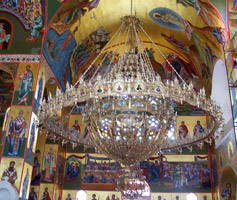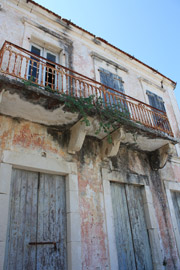During the fifteenth century, thanks to the fact that under the hegemony of Venetian and Turkish, Cephalonia and the Ionian Islands of Greece are the only areas in which there is a rapid flowering of culture that extends to all fields of art and that he had never had before in the history of the island.
The islands under Venetian rule suffered occupation refined and culturally advanced that passed them the elements of Western culture, as opposed to what was happening on the continent Greek who lived devoid not only of his freedom as a nation, but also that of thought and of expression.
The inhabitants of the Ionian islands of Kefalonia and in particular, however, were not sterile receivers of Western influences, but artists and writers took local foreign elements and mixed them with their popular features.
LITERATURE
Developed during the eighteenth century the letters in Kefalonia as well as in other Ionian Islands in Greece.
The literati of Kefalonia distinguished themselves in poetry, prose, in translation, in archaeological research and philosophy.
The most famous are: Andreas Laskaratos (he wrote poems, satires and prose), Spyridon Marinatos (archaeologist), Babis Anninos (poet and journalist).
PAINTING
In Kefalonia, as Zante, lived and worked several painters of sacred images from different areas of Greece.
Begins to develop in the Ionian Islands, in the eighteenth century, an exceptional production of visual art, where painting occupies the first place.
The Western influence is evident and Italian elements blend with the traditional Cretan creating a great stylistic turn.
The most important representatives of religious painting are: Emmanouil Tzanes, Ilias Moschos, Ilias Lambardos and finally Stephanos Tzankarolas. Unfortunately, the violent earthquake in 1953 heavily damaged the churches of Kefalonia and many masterpieces of Cretan painting - Kefalonian were destroyed.
SCULPTURE
From the sixteenth century on Kefalonia began to flourish the art of sculpture, and especially the wooden sculpture, which appears especially in churches with decorative thrones and iconostasis made with fine workmanship.
Many of these works were destroyed during the earthquake, but some have been preserved in churches or are exposed in the collection of the Historical Museum Koryalenio.
Works in marble by the sculptor of the nineteenth century Georgios Bonanos are in the same museum and the cemetery in Argostoli.
ARCHITECTURE
Already in the seventeenth century growing up arts and letters is accompanied by a surprising development of the architecture. 
There is a clear trend towards Western models, but at the same time maintains a color typical of the Ionian Islands.
In the capital city of Argostoli and Zakynthos were mansions, houses very well attended and numerous churches which together reveal the high level of development of the architecture of the Ionian islands.
At the same time the Venetians took care of the defense works and utilities: roads, bridges, public buildings etc.
Later, with the spread of neo-classicism in Europe, new forms begin to characterize public buildings and private homes.
The house in Kefalonia looks bourgeois and recalls the case of mainland Greece. Unfortunately, most beautiful buildings adorning Argostoli, affordable housing god and country churches with their beautiful bell towers are gone.
They keep very few examples that recall the elegance and sobriety of the island of Kefalonia. Some buildings and churches were restored to their original form with great respect and great care thus giving us a picture of Kefalonia as it was before the earthquake.
MUSIC
The rich musical tradition of the island of Kefalonia has its origin in ancient times. During Venetian rule develops and receives, as a natural, Western influence, but without being subjected Skiadaresis, an eminent professor of Kefalonia scholar of music, in his article "Arietta and cantada in their authentic form Kefalonian" reports that the Arietta was born in Kefalonia Lixouri precisely, finally arriving at Zakynthos as "Arekia."
The Arietta, known from the early nineteenth century, is sung according to the conception of the singers singing.
At first it was sung by a trio, but later became a quartet.
The "Ariettes" still continue to be sung in Lixouri by traditional fishermen; the first begins to sing along and follow the rest of the company, but without the accompaniment of a musical instrument.
The popular cantada is different from "Arietta" because the guitar at the beginning gives the tone and the rhythm and then accompanies the song of the group.
DANCE
There were many old dances that were danced in the island of Kefalonia even a few years ago during festivals, carnivals and private parties.
The best known were the "balos" local, the "Diplos", the "ghyres", the "zonaratikos", the "syrtos" and others.
In some festivals again live accompanying the spontaneous amusement of the inhabitants of the island of Kefalonia.
Today, local associations and dance groups try to keep memories alive and make sure you do not miss this precious good of the tradition of the island.
THEATRE
Great was the contribution of the Italian theater in the creation of a public theater in Kefalonia. Initially various Italian theater companies touring gave from time to time representations in Italian and in places suitable for the occasion. Since the beginning of the nineteenth century onward, however, began to be organized theatrical performances in the Greek language.
At first they were amateurs, but later, the arrival of the master Neophytos Vamvas, arrived in Kefalonia to teach ancient Greek literature, improvised a scene with ancient Greek drama recited in ancient Greek.
The audience was really excited and felt a great emotion. Soon the theater gained so many followers who felt the need to create a theater building.
Then the renowned opera house was built in Kefalonia "Kephalos" in Argostoli, which was inaugurated in 1859 with a performance of "La Traviata" by Verdi.
This theater experienced great celebrities with the staging of many classic works of Greek and foreign, as well as different playwrights of the island.
Later a stage was created to hold Argostoli and Lixouri a municipal theater.

|

